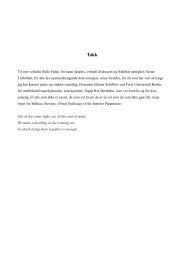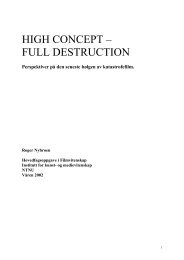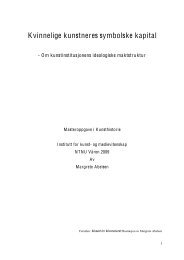Gå til originaloppgave - Masterbloggen
Gå til originaloppgave - Masterbloggen
Gå til originaloppgave - Masterbloggen
Create successful ePaper yourself
Turn your PDF publications into a flip-book with our unique Google optimized e-Paper software.
RESYMÉ<br />
Nasjonalgalleriet ble etablert i 1836 og var Norges eldste kunstinstitusjon. Sammen med fire<br />
andre kunstinstitusjoner, Arkitekturmuseet, Kunstindustrimuseet, Museet for Samtidskunst og<br />
Riksuts<strong>til</strong>lingene, ble museet en del av det nye Nasjonalmuseet for kunst, arkitektur og design<br />
i 2003. I 2005 ble det presentert en ny kontroversiell basisuts<strong>til</strong>ling i Nasjonalgalleriets<br />
tidligere lokaler. Denne temabaserte uts<strong>til</strong>lingen markerte et radikalt brudd med den tidligere<br />
uts<strong>til</strong>lingspraksisen. Etter kraftig kritikk presenterte Nasjonalmuseet en ny basisuts<strong>til</strong>ling i<br />
2007. Denne var på mange måter en gjeninnføring av Nasjonalgalleriets tradisjonsrike<br />
uts<strong>til</strong>ling. I denne masteravhandlingen blir dette skiftet i den nasjonale kunstformidlingen satt<br />
i en større sammenheng. Etter en historisk presentasjon av Nasjonalgalleriet og overgangen <strong>til</strong><br />
Nasjonalmuseet, blir tre uts<strong>til</strong>linger analysert. Disse blir så belyst fra fire ulike perspektiver:<br />
museet i en nasjonal kontekst, overgangen <strong>til</strong> New Public Management, kronologi og<br />
historiefrems<strong>til</strong>ling samt Edvard Munchs arbeider.<br />
ABSTRACT<br />
The National Gallery (est. 1836) was the oldest art institution in Norway. The gallery became<br />
a part of the new National Museum for Art, Architecture and Design in 2003, alongside four<br />
other former institutions: The Norwegian Museum of Architecture, The Museum of<br />
Decorative Arts and Design, The Museum of Contemporary Art and The National Touring<br />
Exhibitions. In 2005 The National Museum presented a new controversial permanent<br />
exhibition in The National Gallery’s former building. This theme based exhibition presented a<br />
radical break with former practice. After a storm of criticism another exhibition was presented<br />
in 2007. This exhibition was similar to The National Gallery’s former one in the same<br />
localities. This thesis explores the shifts and schisms in the organization of these exhibitions.<br />
After a historical presentation of The National Gallery and the establishment of The National<br />
Museum, an analysis of the exhibitions follows. On the basis of this analysis an attempt is<br />
made to shed light on these from four different perspectives: the museum in a national<br />
context, the transition to New Public Management, chronology and the narration of history<br />
and the artist Edvard Munch.<br />
2








